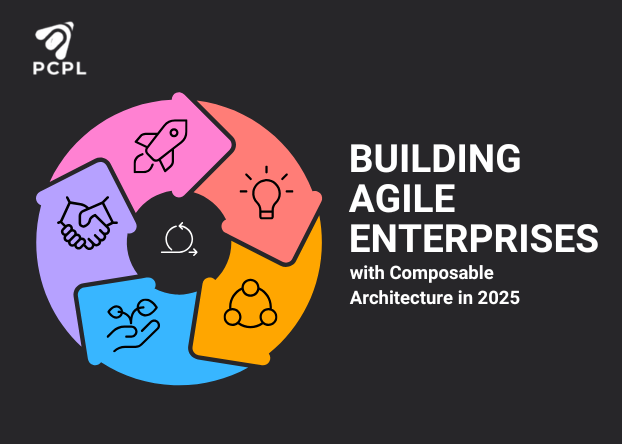
Building Agile Enterprises with Composable Architecture in 2025
Digital transformation is sweeping across every sector, fundamentally reshaping how businesses operate. The urgency for companies to adapt is shown by projections from IDC (International Data Corporation), which estimate global spending on digital transformation will hit $3.9 trillion by 2027.
This significant investment shows an important need for businesses to evolve. As traditional business models shift, organizations are increasingly incorporating successful processes and strategies from diverse industries to unearth novel opportunities and drive innovation.
Traditional IT systems often struggle to keep up with the quickly changing markets today. This is where the concept of a composable business, sometimes called a composable enterprise, comes in. Imagine an organization that’s like a set of LEGO bricks, where each brick represents a business function or capability. These “bricks” can be easily rearranged and reconnected to adapt to new situations.
Instead of being stuck with rigid, all-in-one systems, a composable approach breaks things down into smaller, independent, and reusable parts. This allows businesses to dynamically reconfigure their operations. By using modular architectures, microservices, and APIs, composable applications make these individual business capabilities readily available. This fosters a culture of innovation and allows organizations to rapidly adjust to whatever the market demands.
Core Technologies Enabling Composable Business
Building a successful composable enterprise depends on fully using the API economy. This means every business function, from supply chain to customer service, needs to expose its capabilities via APIs (Application Programming Interfaces). However, effectively integrating and managing these APIs demands a strategic approach.

1. API Management and Integration
Organizations require a strong API strategy to achieve seamless integration across diverse business units. API gateways and management platforms are important tools for monitoring, securing, and scaling API usage throughout the enterprise.
2. Microservices Architecture
Instead of traditional, all-in-one monolithic applications, businesses should adopt microservices. These smaller, independent services can be individually managed, scaled, and updated, offering greater flexibility.
3. Service Mesh
As companies deploy numerous microservices, challenges arise concerning service discovery, traffic management, resilience, and observability. Implementing a service mesh ensures smooth connectivity, governance, and security across these distributed services.
4. Event-Driven Architecture
Event APIs enable business processes to communicate and trigger automated transactions. This significantly reduces latency and enhances real-time decision-making.
5. API-Enabled AI for Adaptive Decision-Making
Exposing machine learning services as serverless functions enables businesses to integrate AI-driven decision-making on demand, making their operations more adaptive.
6. Security and Compliance
Robust security is fundamental within a composable enterprise. Employing a zero-trust architecture is vital to ensure business services remain secure and resilient against cyber threats.
Strategic Roles in Advancing Composability
Achieving a truly composable enterprise, one that can rapidly adapt and innovate by assembling and reassembling modular capabilities, requires strategic leadership from both Enterprise Architects and C-suite Leaders.
A. Enterprise Architects Build the Modular Foundation
Enterprise architects are pivotal in translating the vision of composability into tangible technical strategies. Their key responsibilities include:
- Championing Modular IT- Architects must lead the charge in dismantling rigid, monolithic systems. Their focus should be on creating a modular, API-driven architecture where components can be easily combined and reconfigured to meet evolving business demands.
- Ensuring API Excellence- Establishing robust API governance models is crucial. This ensures that all APIs are consistent, secure, and interoperable across the entire organization, facilitating seamless data flow and integration.
- Bridging Business and Technology- Effective architects work hand-in-hand with business leaders. They align technological capabilities directly with strategic business outcomes, ensuring that IT investments directly support organizational goals.
- Prioritizing Cloud-Native Solutions- To achieve true agility and scalability, architects should advocate for and implement cloud-native platforms and microservices. These modern approaches are fundamental to a composable future.
- Cultivating Experimentation– Architects play a role in promoting an environment where teams feel empowered to rapidly prototype and iterate on new digital services. This allows for innovation without jeopardizing important core operations.
B. C-suite Leadership Drive the Strategic Imperative
The C-suite provides the essential strategic direction, governance, and resources necessary to enable and sustain composability across the enterprise. Their key contributions are
- Establishing Robust Governance and Risk Management- Leaders must define clear policies for API governance, data security, and compliance. This ensures smooth integration while proactively mitigating potential risks.
- Promoting a Culture of Innovation- The C-suite is responsible for cultivating an organizational culture that embraces cross-functional collaboration, experimentation, and a “fail-fast” mindset. This encourages continuous improvement and rapid adaptation.
- Dealing with Regulatory Complexities- Leaders must ensure the organization remains compliant with industry regulations and data privacy laws without sacrificing the agility needed for business operations.
- Investing in Scalability and Future-Proofing- Strategic investment in cloud-native architectures and modular capabilities is vital. This prepares the organization to seamlessly adapt to future market shifts and technological advancements.
- Building Strategic Ecosystem Partnerships- Collaborating with technology providers, innovative startups, and industry consortia allows organizations to co-innovate, share knowledge, and accelerate their digital transformation journey.
Businesses embracing a composable approach are fundamentally transforming how they function, compete, and expand. Organizations that adopt composability will be able to adapt more quickly, deliver better customer experiences, and discover new revenue opportunities in our increasingly interconnected digital landscape.
It’s clear what’s needed- businesses must implement API-first, flexible ecosystems to be leaders in this age of digital agility.
References
https://www.sap.com/uk/blogs/creating-composable-business
